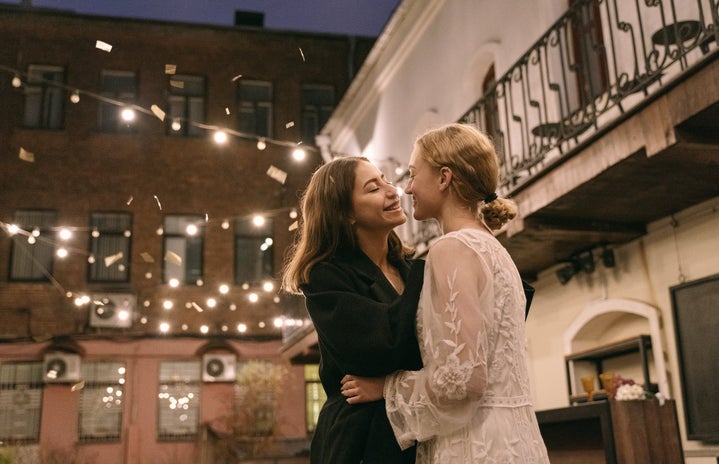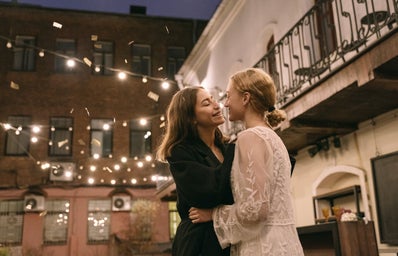(Contains spoilers about the named shows!)
It was an average Saturday night for my girlfriend and I, huddled underneath a blanket heap in front of the TV and discussing whether or not Shane McCutcheon (Kate Moennig) “deserves rights” or not after jilting her long-term girlfriend Carmen de la Pica Morales (Sarah Shahi) at the altar (I voted yes, my girlfriend, a strong no). Both are characters from the 2000s TV hit The L Word, a show that seems like a lesbian rite-of-passage to have watched through its heralding as a pinnacle moment in many “baby gays” coming-out experiences, from filling the hole left by the desire for “a queer friendship group” to being the first show that presented queer women “as people”. And in the midst of the excitement of connecting with my girlfriend over a fictional lesbian drama, I came to the realisation that this was the first time either of us had consumed a wholly sapphic TV show, despite both of us identifying as queer since we were young teenagers.
Unfortunately, The L Word is one of very few examples that allow for sapphic relationships to take centre stage, and the range of lesbian and bisexual representation doesn’t seem to be widening even though we are 2 decades deep into the 21st century. While there have been attempts at establishing sapphic-focused stories, they are often struck down at the first hurdle – a number of Netflix productions such as I Am Not Okay With This and Everything Sucks!, both of which had queer female leads, were cancelled immediately after their first season. And this is not because of low ratings or poor reviews; Netflix received backlash when First Kill, a sapphic teen-romance vampire series, garnered over 30 million hours of viewing within the first 3 days of release and was still denied a season 2. There’s clearly a demographic and a desire for specifically queer female stories (we do exist!), so why are they not being given a chance in the media?
Could it be that in a patriarchal world that struggles to conceive the possibility of women having lives that do not centre around men, there is simply no place for sapphism? Not in society, and especially not within film and TV, it seems. The LGBTQ+ community are, of course, only fed teaspoon-sized spaces of representation within the media anyway, but when we are, queer stories tend to focus around romances between gay men. Shows such as Young Royals and Heartstopper both have queer male love stories at their centre and are already promptly in production for their third seasons. According to Adrienne Shaw, an associate professor in the Department of Media Studies at Klein College of Media and Communication, this is likely due to queer men being seen as “non-threatening”, meaning they are able to be “marketed to straight female audiences”, thus appealing not only to LGBTQ+ audiences, but straight women as well.
While Heartstopper does feature a lesbian relationship between characters Tara and Darcy, they are a secondary subplot pushed to the side and given the “side gays” treatment – a common trope in film and TV where productions sprinkle in a little sapphic representation, but are too scared to actually commit to it predominantly. A lot of shows and movies are also perpetrators of the “Burn Your Gays” trope, sometimes known as Dead Lesbian Syndrome, wherein queer female characters are brutally murdered, usually when the sapphic relationship is just beginning to be established. As of February 2023, there are over 230 characters victimised by this trope, such as Buffy the Vampire Slayer’s Willow and Tara.
In the rare event that queer women are offered full representation, they are most often problematic. Successful lesbian productions, such as Blue Is The Warmest Colour (2013) and Below Her Mouth (2016), and even mine and my girlfriend’s beloved The L Word, are overtly and graphically sexual in their content. It seems that they are, unfortunately, mostly successful because of their pandering to straight male audiences, appealing to the historic sexualisation of lesbian relationships where lesbian sex has always been made palatable to straight men in a heteronormative world that objectifies its women – in 2022, “lesbian” was the most-searched term on various explicit sites. Not only this, but representations are often very white, and very femme-for-femme. According to film and TV, queer women of colour and “masc” (masculine) lesbians are pretty much non-existent, and therefore, apparently invalid.
When I was seventeen, I was struggling with coming to terms with the realisation that I may not end up marrying the man who stood underneath the altar of my daydreams, blurry-faced and palm-outstretched with the promise of stability and biological children. It wasn’t until I watched Netflix’s Atypical and witnessed the romance between characters Izzie and Casey that I realised that daydream wasn’t even what I really wanted, it was just an ideal that had been shoved down my throat since I spoke my first words. Izzie and Casey were presented like any other first love – thrilling, pure, and a little bit messy – it just so happened that it was sapphic.
Representation allows us to see ourselves in people and situations that we may not have access to in real life. It is often a crux on which many people depend, a salvation in times of need where we may feel alienated to those around us, and this is why the lack of decent sapphic representation in the media at the moment needs to change. Queer women, especially young queer girls, need to be shown that while they do not fit into the boundaries of heteronormativity, they are valid, and will be able to find healthy, long-lasting relationships in the future. Sapphic love is just as important as any other kind. It deserves to be represented on screen.


